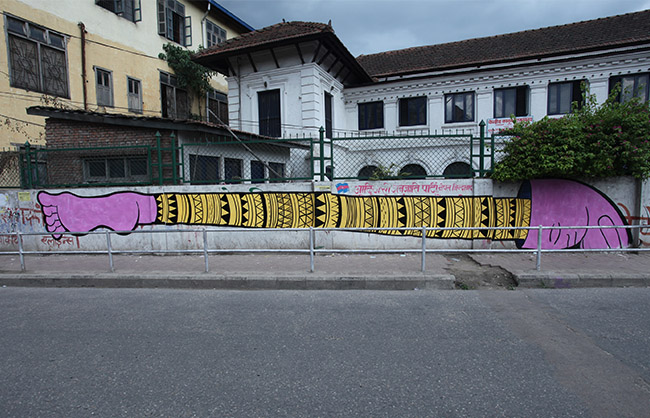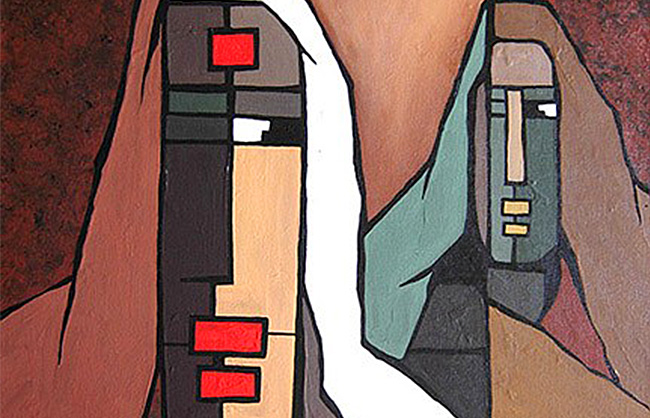Writing
Project Details
Title: Reimagining the streets
Category: Writing
Date: 10 November 2015
Share:
A number of graffiti works—somewhat unusual for the Kathmandu cityscape—began appearing on walls in Jamal, Kantipath, Pulchowk and Lainchaur, all around the same time this month, making pedestrians stop in their tracks to take a closer look. Kathmandu natives have learned long ago to filter out and ignore the bold red onslaughts of political slogans on walls. But the new murals that came up on the streets, seemingly overnight, were different; they made people curious, they were noticed.
Letterings and painted imageries were seen around the city, but for a change, these were not political; the artists responsible had no visible political leanings. They were anonymous painters, interacting with the public through their colours and ideas, refurbishing the streets that were once laden with pesky slogans and film posters.
Four artists—Bruno Levi, Yeti, Rainbow Warrior and Mr. K—were responsible for these particular works, representing a new wave in Nepali street art. Surprisingly, they did not know much about each other until Bruno and Yeti’s artwork appeared alongside graffiti by Rainbow Warrior and Mr. K.
Bruno Levi, an artist from New York, has been involved in street art from his teens. He has a history of working with video, photography, music, painting, drawing and tattooing. A graduate in Arts from Tisch School of the Arts at New York University, he worked for a time as a travel photographer, capturing everything from the Dalai Lama to underwater battles between hammerhead sharks and dolphins in the Marquesas in French Polynesia. Since 2006, Bruno has been visiting Nepal repeatedly, but it wasn’t until 2008 that he took up graffiti in Freak Street. More recently, he has painted over the walls of Jamal, Lainchaur and Kaisermahal.
Unlike Bruno, Yeti does not want to be identified. A native of Kathmandu, she lived between New York and Philadelphia while studying art at Temple University a few years ago, working at the same time on her portfolio of intricate psychedelic illustrations and patterns. Motivated by the unaltered impact that street art has on viewers, Yeti then started doing murals in Basantapur, Paknajol and even an entire wall on Freak Street. This year, Yeti has teamed up with Bruno, working on the streets next to the Ambassador Hotel in Lazimpat, in Basantapur and the one opposite the Ministry of Foreign Affairs. Although graffiti is often assumed to be a largely male-dominated art form, Yeti challenges that assumption.
Rainbow Warrior, too, maintains anonymity and prefers to be recognised by his work. Originally from Paris, he has worked in studios in England and describes himself as a graphic artist and product designer. Growing up in a city with a thriving graffiti culture, Warrior’s love affair with street art was inevitable. One of his works comprises of an iconic old letterbox in Lainchaur played up in bright rainbow hues. “Today all you see around are very negative slogans,” says Warrior. “Through our work, we’re trying to bring poetry to the streets of Kathmandu, things that will make people think for a second or two—if we succeed, then that is art.”
For Nepali artist Mr. K, it was the rigidness and boundaries of gallery art that led him to seek a larger, more versatile canvas. And city walls seemed to fit the criteria. Having already exhibited in galleries, Mr. K believes graffiti allows for a more direct dialogue with people.
Mr. K and Rainbow Warrior recount how they got started in street art. Together, they’d decided to do some graffiti around Kathmandu and went to the municipality for permission. It was denied. The artists, however, were not deterred; in fact, this setback itself became inspiration. A few days later, a wall in Jamal read “WARNING”, in bold red letters, against a black background. And the very next day, Bruno and Yeti were found painting right next to “WARNING”.
Graffiti is becoming an increasingly popular cultural movement in the West, hailed as one of the most uniquely postmodern forms of artistic expression, although it is still illegal. In Nepal, however, the lines are blurred. When you have city walls that are already buried under film posters, advertisements and painted campaign announcements, there are few mechanisms to prevent street art. Besides, these works provide interesting visuals and a welcome relief from the gaudy mess that is generally seen on walls; an embryologic cord coming out of the head of a foetus-like figure, connecting to a television set, a cord coming out of a head and morphing into a leg or the sign that reads: “Mummy told me not to do politics.” Invariably distinct.
Could this be conceived as vandalism? Yeti says no. “We choose places that are already dwindling or falling apart, and Kathmandu has plenty of those,” Yeti says. “Our works are not apprehensive; they are a sort of cleaning, rather than polluting.” Bruno reiterates this, explaining that their art doesn’t destroy but instead “improves the state and look of things we paint over.”
As art is defined by the intent of the artist, vandalism is determined by the response of whoever is in possession of the vandalised property. In this case, the Kathmandu Municipality. “We asked them for permission to paint on the walls—paint good things, positive messages—and they weren’t willing,” says Mr. K. Rainbow Warrior expresses similar frustration with the inaccessible attitude of the municipality. “If political slogans are allowed, why not something that is good?” he questions. Despite these tussles, he says there have been many encouraging moments, like when a military employee stopped and posed beside the letterbox for a photo, or when pedestrians thanked them for cleaning the country. Once, two policemen even helped them clean the wall before painting and another time, two CA members came by and appreciated their work.
While having seen their murals, you might not have observed the artists at work. They adore the idea of sneaking off into the night and doing an image anonymously—that mystery and intrigue has always been a big part of the lure of street art. “It’s not about getting popular, it’s about expressing yourself. You gain happiness from what you do, and that’s the only driving factor,” says Yeti. Bruno agrees. “I want to respect the place and create a dialogue with the people,” he says. “The reaction I get from them is humbling. You do it because you love it.”
The considerable popularity of street art rests largely on the notion of non-commercialism. This art form is more accessible to the general public than say, the overexposed profiles of the curatorial circuit. “Exceptions aside, I would not want to paint someone’s restaurant for money, it would feel like selling out,” Yeti says. The beauty of graffiti lies thus, in its free-for-all approach; the sense that it exists “outside” the mainstream art industry, representing a true democratisation of art. How do you pay or ask for freedom? You don’t, you take it. That is what these artists are doing. They are reclaiming public space. Of course, the medium is still in its infancy in Nepal. Graffiti in the west is generally characterised by its explicit denunciation of commercial brands and restrictive legal norms, but the street art scene here has yet to see a definitive rise in this regard. The search for our very own Banksy continues.
As adventurous as their exploits might be, the artists agree that these projects do require monetary backup, for which they have to rely on other jobs. “We would love to paint day and night, but you need to make a living,” expresses Mr. K.
About a decade ago, Spade Invader, one of the best-known names in street art, did some pieces around Kathmandu, most of which still exist. And over the years, Nepal has seen some repetitive tagging as well; the letterings that read “Khoj”, or the inverted question marks. But the most recent wave of graffiti goes beyond tagging. Art students and select groups in Kathmandu such as e3, for instance, have been painting extensive images on walls, albeit within a selected territory.
“Anyone can do graffiti, but only a few can touch people. The art has to make them think and feel,” says Rainbow Warrior. With more and more artists becoming attuned to the aesthetics of street art, the dirty walls littered with gaudy political agendas and tattered advertisements wait to be washed over with the colours of true, uninhibited expression.
As for the future, the artists have big plans. “There are many places we want to work on,” they say. At a time when the landscape is overrun with corporate logos and slogans, street art rejuvenates public space, to counter, in its own way, the effects of this culture of overconsumption. Graffiti corresponds to the energy and life of a growing city, taking inspiration from the changes within it. And Kathmandu appears to be a fitting muse.
Please visit the Features Section on http://www.ekantipur.com/ to watch the video of the artists at work
Printed on JUN 03








